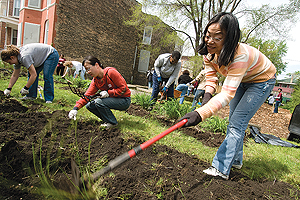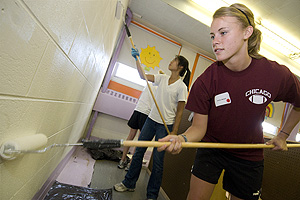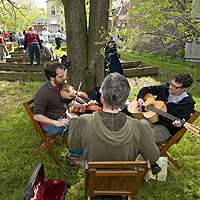Medical Center’s Day of Service: A day of giving and receiving
By Deva Woodlydeva@uchicago.edu
News Office
 Photos by Lloyd DeGrane Xinan Yang (in foreground), a postdoc in Biology, tills the soil in a vacant lot across the street from Emmett Till Elementary School on the South Side of the city. Volunteers dispersed across Chicago to 23 volunteer sites on a recent Saturday morning for the University Medical Centerís annual Day of Service and Reflection. |
|
 Students plant peppers at one of the volunteer sites on the South Side of Chicago at 89th Street and Buffalo. From the foreground clockwise are Caroline Ouwerkerk, Boryana Levterova, Hannah Fine and Li Cai. |
|
 Members of the womenís soccer team and second-years Emily Benoit (foreground) and Sarah Loh, paint classroom walls at Firman Preschool on 47th Street. |
|
After a day of hard work among friends and neighbors, community volunteers participating in the University Medical Center’s Day of Service and Reflection begin to understand the fine line between giving and receiving.
Not only does the boundary between give and take dissolve during a day of service, but so do many of the cultural differences between the people who have come to work together.
On one of the first sunny, warm spring days in May, more than 350 volunteers met at 8 a.m. at the Friends Family Health Center in Hyde Park, where they boarded buses and fanned out to 23 service sites across Chicago’s South Side.
Initiated seven years ago by First Lady Michelle Obama, when she was Vice President for Community and External Affairs for the University Hospitals, the Medical Center’s Day of Service and Reflection remains one of its signature events.
In the words of Leif Elsmo, Executive Director of the Office of Community Affairs, its purpose is “to bring together University of Chicago Medical Center employees and neighborhood residents, working side by side to enhance our community through meaningful service.”
Susan Peters, the Manager of Community Relations at the Medical Center’s Office of Community Affairs, said: “One of the anchoring principles of service has to be reflection. We think we do something for someone else, but when you reflect, you realize how much you have received.
“Often we are working in areas and groups where people are different from each other culturally, in terms of socioeconomic status and tastes, but during the course of the service, working together, you connect with the humanity and the human situations of other people.”
At Emmett Till Elementary School in Englewood, a jaunty group of about 30 adults and students revitalized a garden near the school grounds, planting perennial flowers near the front gate and setting up boxes for a vegetable garden in the back. A group of four Hyde Park musicians provided cheerful acoustic tunes to accompany the gardening.
Kierra Wilson, a fifth-grader who had dedicated her morning to breaking up wood chips to be used as fertilizer, described the reason she was there. At first she shrugged, saying, “I didn’t have anything better to do,” but then she paused and said with a shy smile, “plus, some things need to change around here, and I wanted to make a change.” Ricky Hill, another fifth-grader at Emmett Till, was carting around a wheelbarrow of dirt for similar reasons, “I figured,” he said with a grin, “it was a good thing to do.”
Each year, the Day of Service and Reflection has grown, often doubling in size from one year to the next. Elsmo remembers the first year, in which two buses took 32 participants to six sites.
“It was small, but everyone got it immediately,” said Elsmo, “When we were coming back on the buses after doing the service, we talked about it—about the impact that it had on each of us and the people we’d gotten to meet.” That reflection was an important part of the experience, and the Medical Center has since made reflection an integral part of its volunteer service day.
Elsmo believes that the reflective part of the day is similarly important. “Every year someone says, ‘I had no idea!’ I had no idea how cool, how dedicated, how down-to-earth, how dynamic, how much good gets done and how much of a difference so many organizations in our surrounding communities are able to make.”
 Three Hyde Park musicians, Paul Harnik, Anna Lee Kohn and Danny Miller, entertain a group of volunteers who were creating some community green space during a Day of Service and Reflection sponsored by the University Medical Center. |
|
This annual event is crucial because it provides an opportunity for the medical staff and their families to get to know the people and organizations in the community they serve. “The Day of Service and Reflection gives people an occasion to have a different kind of experience,” Elsmo said.
At the Emmett Till community garden, there were children and adults of all ages, races and from several different neighborhoods.
At one point, the head gardener exhorted the crowd to “take 30 seconds to dance to the music” provided by the folksy quartet. Many of the children, both students at Emmett Till and the children who have come along with the University medical staff, bounded around the garden, shimmying and swaying as they giggled.
The adults chattered animatedly to one another, as they looked over the neat, curving rows of green shoots peppering the space, which had been a mess of dirt and wood chips when they arrived.
A lot of progress had been made in a single day.
![[Chronicle]](/images/sidebar_header_oct06.gif)